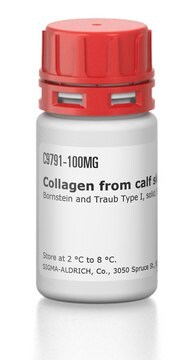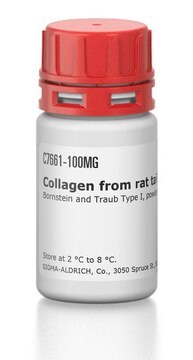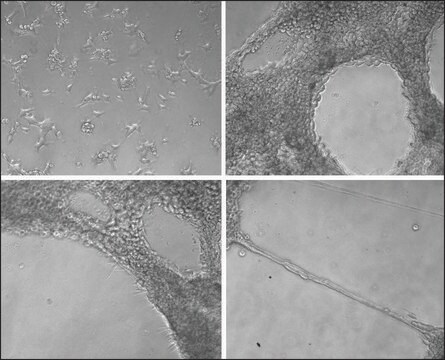C0543
Rat Collagen Type IV
from Engelbreth-Holm-Swarm murine sarcoma basement membrane, lyophilized powder, suitable for cell culture, used for 3D hydrogel formation
Sinónimos:
Type IV collagen, EHS-collagen
About This Item
Productos recomendados
product name
Collagen from Engelbreth-Holm-Swarm murine sarcoma basement membrane, Type IV (Miller), lyophilized powder, BioReagent, suitable for cell culture
biological source
mouse (Engelbreth-Holm-Swarm murine sarcoma basement membrane)
Quality Level
type
Type IV (Miller)
product line
BioReagent
form
lyophilized powder
packaging
glass bottle of 1 vial
technique(s)
cell culture | mammalian: suitable
surface coverage
6‑10 μg/cm2
solubility
0.25% acetic acid: 0.5-2.0 mg/mL (Keep at 2-8 °C for several hours, occasionally swirling.)
shipped in
dry ice
storage temp.
−20°C
Gene Information
mouse ... Col4a1(12826) , Col4a2(12827) , Col4a3(12828) , Col4a5(12830) , Col4a6(94216)
General description
Application
- in adhesion assays.
- in hydrogel fabrication.
- to coat cell culture plates for cell differentiation.
- to treat round plastic coverslips for scanning electron microscopy (SEM) analysis in an interaction study between A. culbertsoni trophozoites and Schwann cells.
Biochem/physiol Actions
Other Notes
Quantity
Preparation Note
Pepsin is not used in the preparation.
Storage Class
11 - Combustible Solids
wgk_germany
WGK 1
flash_point_f
Not applicable
flash_point_c
Not applicable
ppe
Eyeshields, Gloves, type N95 (US)
Certificados de análisis (COA)
Busque Certificados de análisis (COA) introduciendo el número de lote del producto. Los números de lote se encuentran en la etiqueta del producto después de las palabras «Lot» o «Batch»
¿Ya tiene este producto?
Encuentre la documentación para los productos que ha comprado recientemente en la Biblioteca de documentos.
Los clientes también vieron
Artículos
3D cell culture overview. Learn about 2D vs 3D cell culture, advantages of 3D cell culture, and techniques available to develop 3D cell models
Cancer stem cell media, spheroid plates and cancer stem cell markers to culture and characterize CSC populations.
Extracellular matrix proteins such as laminin, collagen, and fibronectin can be used as cell attachment substrates in cell culture.
Nuestro equipo de científicos tiene experiencia en todas las áreas de investigación: Ciencias de la vida, Ciencia de los materiales, Síntesis química, Cromatografía, Analítica y muchas otras.
Póngase en contacto con el Servicio técnico






